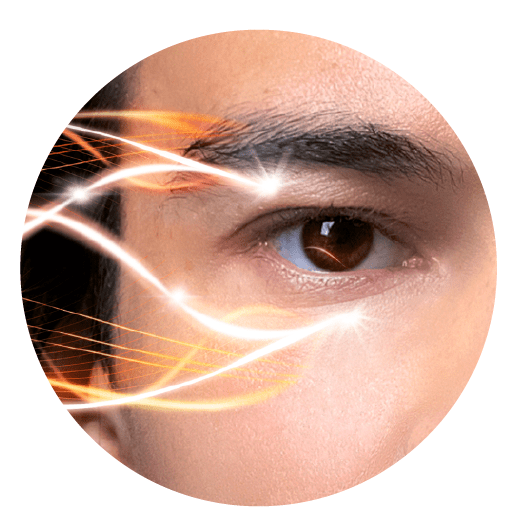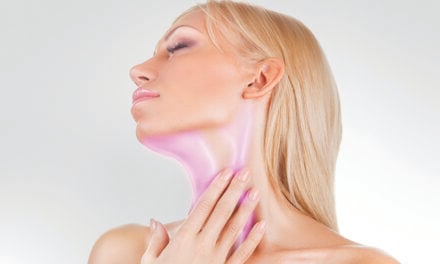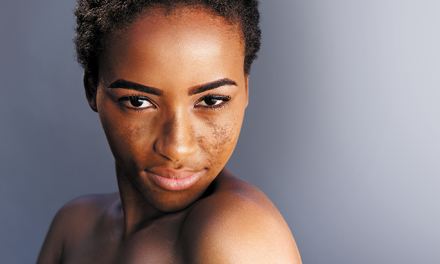Ultrasound, similar to audible sound, is an oscillating pressure wave; however, it has a frequency beyond the limit of the human hearing1. Since ultrasound will return as an echo when directed at solid objects, diagnostic ultrasound or sonography has been used in human medicine for many years. The properties of ultrasound also enable it to be focused like a beam of light with a high degree of precision. At frequencies of 1–7 MHz, ultrasound can be very tightly focused2. If directed toward body tissue and the power of the ultrasound source is sufficiently high, the temperature will increase to more than 60 °C within the focal zone, causing tissue proteins to coagulate. This is referred to as high-intensity focused ultrasound (HIFU). An important aspect of HIFU is that although the damaging focal point is located several millimeters below the surface of the skin, tissue above and below the focal point remain unaffected1. HIFU has become an important tool for treating serious medical conditions such as tumors3. More recently, the development of micro-focused ultrasound (MFU) enables targeting the facial superficial musculoaponeurotic system4.
Preclinical studies
Superficial musculoaponeurotic system
The superficial musculoaponeurotic system (SMAS) is a subcutaneous, fan-shaped structure that covers the face5 and connects the facial muscles with the dermis6. It has been described as a composite fibro-fatty layer made up of elastic fibers in close relationship to collagen fibers interspersed with fat cells7. Superiorly, it is attached to the internal aspect of the frontalis muscle, and inferiorly it is continuous with the platysma muscle5. Anteriorly, it is contiguous with the platysma muscle and also part of the orbicularis oculi muscles. Within the nasolabial fold region, it is connected to the levator labium superius oris, orbicularis oris, depressor anguli oris, and risorius muscles. Posteriorly, its attachments include the perichondrium of the tragal cartilage and the sternocleidomastoid muscle on the mastoid. The most common SMAS architecture (Type 1) is a meshwork of fibrous septa which envelops fat cells6.
The interconnecting fibrous network is anchored to the periosteum or connected to the facial muscles. Type 1 SMAS morphology is found in the forehead, parotid, zygomatic, and infraorbital areas and also in the lateral part of the nasolabial fold and is more susceptible to the effects of ageing6. The second architectural model (Type 2) is a meshwork of intermingled collagen and elastic fibers and muscle fibers found in the upper and lower lip6.
Effects of micro-focused ultrasound on the superficial musculoaponeurotic system
Thermal injury is known to cause collagen to contract; however, prior to the introduction of HIFU to cosmetic dermatology, this effect was limited to the application of superficial heat such as lasers8,9. Preclinical studies involving the use of HIFU to treat the SMAS were initially performed using ex vivo porcine tissues10 and human cadaver facial tissue11,12. By manipulating the ultrasound frequency, focal depth, power output, and duration of exposure, the temperature within the dermis could be briefly raised to 60 °C resulting in a discrete and reproducible zone of thermal coagulation. These small (<1 mm3) volumes of coagulated tissue are made possible by the relatively short exposure duration and sharp MFU12. Each application of MFU to the SMAS resulted in small but consistent levels of collagen contraction while the skin and intervening tissues were unaffected.
Based on these promising results, an open-label, phase 1 study was performed which enrolled subjects scheduled to undergo rhytidectomy at various times following MFU treatment13. Three transducers were used with a frequency/focal depth of 7.5 MHz/3.0 mm, 7.5 MHz/4.5 mm, and 4.4 MHz/4.5 mm, which created superficial, intermediate, and deep thermal injury zones, respectively, to tissue scheduled for excision. Seven patients underwent rhytidectomy within 24 hours after MFU treatment and eight patients underwent rhytidectomy after 4 to 12 weeks (mean, 5.5 weeks). On histologic examination, thermal injury zones were consistently identified in the dermis at exposure levels >0.5 Joules as focal areas of denatured collagen. These thermal injury zones were produced in the expected linear pattern and were consistent in size and depth from zone to zone. Increasing source power did not increase the depth of the epicenter of the thermal injury zone.
Micro-focused ultrasound with visualization system
Currently, only one non-invasive aesthetic treatment using MFU-V has been cleared by the US FDA (Ulthera System; Ulthera, Inc., Mesa, AZ). The device is currently indicated for use as a non-invasive dermatological aesthetic treatment to lift the eyebrow, lax submental and neck tissue and is the only non-invasive treatment specifically cleared by the FDA for improving lines and wrinkles of the décolleté14. An integral part of the device is the Ulthera DeepSEE transducer which permits ultrasound visualization of target tissues up to 8 mm below the surface of the skin. The visualization transducer ensures proper coupling of the transducer to the skin, confirms appropriate treatment depth, and avoids non-target tissue, such as bone. The available frequency/focal depth transducers include a 4 MHz/4.5 mm, 7 MHz/4.5 mm, 7 MHz/3.0 mm, 10 MHz/1.5 mm, and a 7 MHz/3.0 mm narrow focal depth transducer. Each transducer delivers a beam of HIFU to the selected focal depth where tissue is heated to >60°C at the 1–1.5 mm3 thermal injury zone and collagen undergoes thermal coagulation.
Application of MFU-V
The choice of which transducer to use depends on the anatomical area being treated. For example, areas with the thinnest skin, such as the neck and periocular area, should be treated with superficial depth probes15. The brow and temple should be treated with superficial and deeper probes, while cheeks and submental skin is best treated with the deepest 4 MHz/4.5 mm transducer followed by additional treatment with a superficial transducer15. As described below, the use of dual depth MFU-V treatments may enhance treatment effectiveness.
Ultrasound gel is applied to the skin and the transducer is placed on the target site so the entire transducer is evenly coupled to the skin surface. Correct coupling can be confirmed by using the visualization function to obtain an ultrasound image of the target area. Parallel MFU-V treatment lines up to 25 mm in length are manually delivered to the target area and spaced 2 to 3 mm apart. The overall number of lines applied to a treatment area depends on the size of the area and chosen protocol. Treatment guidelines including transducer selection and suggested treatment patterns over different areas of the face are provided by the manufacturer16.
Precautions
The most worrisome potential complication is motor nerve paresis. The areas at the greatest risk for injury are the temporal branch of the trigeminal nerve and the marginal mandibular nerve, where the depth of the nerve becomes relatively superficial15. Among the 39 MFU-V-treated patients in one recent report there was high incidence of transient buccal (N=1), marginal mandibular (N=1), and frontal branch nerve paralysis (N=1)17. These effects can be prevented by avoiding treatment directly over the mandible or facial nerves. Because there are no commercially available eye shields known to protect the eye from ultrasound energy, treatment should not be done inside the orbital rim15. The thyroid gland should be marked before treatment to avoid inadvertently exposing the area to ultrasound energy.
Contraindications
Contraindications to the use of the MFU-V system include the presence of open wounds or lesions, severe or cystic acne, the presence of active implants (such as pacemakers and defibrillators) or metallic implants in the planned treatment area, and pregnancy. Relative contraindications include illnesses, conditions or medications that may impair wound healing.
Clinical studies
Efficacy of MFU-V for lifting lax skin on the face and neck
Single-depth treatment
Techniques for achieving skin lift and tightening with MFU-V are continuously undergoing change and refinement. The first published clinical MFU-V trial was a blinded, prospective cohort study18. Three MFU-V transducers with a frequency/focal depth of 4 MHz/4.5 mm, 7 MHz/4.5 mm, and 7 MHz/3.0 mm were applied as a single treatment to the forehead, temples, cheeks, submental region, and side of the neck. The choice of transducer was based on skin thickness. Among the subjects evaluable at 90 days post-treatment (N=35), 86% were judged by blinded clinician evaluators to show clinically significant brow lift (p=0.00001) with a mean maximum brow elevation of 1.9 mm.
Other studies have also demonstrated the beneficial effects of treating the face and neck with single-depth MFU-V. Among subjects treated with 7.5 MHz/3.0 mm and 4.4 MHz/4.5 mm transducers (N=22), all showed nasolabial fold and jaw line improvement19.
Dual depth MFU-V treatment
A refinement to treatment with MFU-V is the use of two transducers with different focal depths to treat the same area. One study compared improvements to the neck following single- and dual-depth MFU-V treatment20.Among subjects receiving a single (3 mm) depth treatment on the neck (N=34), blinded assessment indicated 74.2%, 78.1%, and 42% of subjects were improved at 60, 90, and 180 days, respectively. Among subjects receiving dual depth (3 mm and 4.5 mm) treatment, 53.3%, 79.3%, and 93.1% were improved at 60, 90, and 180 days, respectively.
The effect of dual depth MFU-V treatment was also assessed on facial areas including the temples, cheeks, submental region, and neck using 4 MHz/4.5 mm and 7 MHz/3.0 mm transducers21. After 90 days, blinded clinician evaluators judged 8 of 10 evaluable subjects (80%) as showing clinical improvement. Specifically, two were significantly improved, four were moderately improved, and two were mildly improved. Based on subject self-assessment, 90% of subjects were improved.
The largest clinical study of the effectiveness of MFU-V for rejuvenating the lower face was a prospective non‑randomized clinical trial (N=103)22. Three-dimensional images obtained at baseline and 3 months post-treatment were assessed qualitatively by three blinded reviewers and quantitatively using three-dimensional computer software. Among the evaluable subjects (N=93), qualitative improvement in skin laxity was observed in 58.1% of patients and quantitative noted overall improvement in skin laxity in 63.6% of subjects. No change was detected in 54.5% of subjects with BMI >30 kg/m2 vs. 12.2% of subjects with BMI ≤30 kg/m2. At day 90, 65.6% of subjects perceived improvement in the skin laxity of the lower half of their face and neck.
The effect of dual-depth MFU-V is also very durable. Following a single dual-depth treatment of the face and upper-neck treatment using 4 MHz/4.5 mm and 7 MHz/3.0 mm transducers, the proportion of subjects showing any level of improvement based on investigator assessment at 90 days (N=16) and 180 days (N=45) was 81.3% and 77.7%, respectively. The proportion of subjects that believed they demonstrated improvement in appearance was 75% and 77.8% at 90 days and 180 days, respectively23.
Dual-depth treatment with vectoring
A recent study evaluated the use of dual depth MFU-V for lifting and tightening facial and neck skin with the addition of vertical vectoring and by increasing the number of treatment lines24. In one group of subjects (N=107), dual-depth MFU-V was administered as follows:
7 MHz/3.0 mm and 7 MHz/4.5 mm (15 lines, 423 J each) to each lateral brow and crow’s feet
7 MHz/3.0 mm and 4 MHz/4.5 mm (15 lines, 461.2 J each) to each malar bag
7 MHz/3.0 mm and 4 MHz/4.5 mm (60 lines, 1845 J each) to each half of the face
7 MHz/3.0 mm and 4 MHz/4.5 mm (75 lines, 2306 J each) to the entire neck.
The fibromuscular layer and dermal treatment lines above the superolateral brow were treated in vertical directions but administered horizontally within crow’s feet sites. The fibromuscular and dermal treatment lines within the malar bag site were placed in a superomedial direction. Fibromuscular treatment lines in the face and neck were positioned in a horizontal direction, and dermal treatment lines were placed superolaterally. In another group (N=55), subjects received twice as many MFU-V treatment lines and therefore twice the total energy as the first group except the malar bag area which remained unchanged:
7 MHz/3.0 mm and 7 MHz/ 4.5 mm (30 lines, 847 J) to each lateral brow and crow’s feet
7 MHz/3.0 mm and 4 MHz/4.5 mm (15 lines, 461.2 J) to each malar bag
7 MHz/3.0 mm and 4 MHz/4.5 mm (120 lines, 3690 J) to each half of the face
7 MHz/3.0 mm and 4 MHz/4.5 mm (150 lines, 4612 J each) to the entire neck.
Three months after treatment, two blinded evaluators determined 51.4% of patients in the first group (fewer lines, lower energy) were responders (mild: 47.2%, moderate: 52.8%) increasing to 70.3% (mild: 31.1%, moderate: 68.9%) at 6 months. In contrast, 71.2% of patients in the second group (more lines, higher energy) were responders at 3 months (mild: 34.0%, moderate: 47.6%, significant: 18.4%) increasing to 80.2% (mild: 10.4%, moderate: 63.4%, significant: 26.2%) at 6 months.
Efficacy of MFU-V for lifting lax skin on the periorbitum
MFU-V has also been used for non-invasive eyelid rejuvenation. In one study, subjects with infraorbital laxity (N=15) received one treatment with a single depth of MFU-V applied to the periorbital area using a 7.0 MHz/3.0 mm transducer25. After 6 months, blinded evaluator assessment indicated 13.33% were much improved, 73.33% were improved and 13.33% were unchanged. Treated subjects rated themselves as much improved (20.0%) and improved (80.0%).
The effects of a single treatment using dual levels of MFU-V applied to the periorbital area were also assessed in subjects with mild-to-moderate crepey skin outside the orbital rims and mild-to-moderate skin ptosis (N=19)4. MFU-V was applied using 7 MHz/3.0 mm and 19 MHz/1.5 mm transducers across the upper lid-brow complex, lateral canthal area, and below the lower lid margin. To prevent intraocular injury, dual depth treatment was limited to tissue over the orbital portion of the orbicularis muscle and bone. After 6 months, the single dual-depth treatment of MFU-V resulted in a mean brow elevation 1.7 mm. This compares favorably with treatment using radiofrequency which raised brow height a mean of 1.30–1.49 mm26. Based on global investigator and subject assessments, improvements in wrinkled and crepey skin were observed as early as 6 weeks becoming more appreciable between 3 and 6 months. These improvements were maintained from 6 to 18 months.
Efficacy of MFU-V on the décolletage
The beneficial effect of MFU-V for treating the décolleté area was initially assessed in a pilot study with five women using 7 MHz/3.0 mm and 10 MHz/1.5 mm transducers4. Improvements in wrinkled and crepey skin was observed as early as 6 weeks with maximum smoothing and tightening occurring between 3 to 6 months and lasting from 6 to 18 months.
To assess its efficacy on the décolleté in a larger population, 120 lines of MFU-V was first administered using the 4 MHz/4.5 mm transducer followed by 120 lines using the 7 MHz/3.0 mm transducer (dual depth)27. Rhytids improved over time, with 46% and 62% of subjects showing a 1- to 2-point improvement at days 90 and 180, respectively, based on a 5-point numeric rating system. Mean (SD) mid-clavicular to nipple distance significantly decreased from 20.9 (1.57) cm at baseline to 19.8 (1.50) cm and 19.5 (1.59) cm, at days 90 and 180, respectively. At day 90, 100% were improved by subject assessment and 96% were improved by physician assessment. At day 180, 95.2% of subjects were either satisfied (52%) or very satisfied (43%) with the results they achieved.
Efficacy of MFU on other anatomical areas
Although not cleared for these uses, MFU-V has also been used to non-invasively lift and tighten lax skin in other anatomical areas including the upper arms4,28, elbows29, thighs4,28, knees4,28,30, and buttocks4,31. Similar to areas of the face, neck, and décolleté, single- and dual-plane treatment of these areas with MFU-V also resulted in significant improvements in global assessment scores that in some cases continued to improve between 3 and 6 months following treatment28 and persisted for 6 to 18 months4,29–31.
Safety
Face and neck
In all published studies, MFU-V has been reported to be very well tolerated. Most patients receive oral nonsteroidal anti-inflammatory or opiate medication prior to treatment and occasionally with topical lidocaine13,23. Based on an 11-point (0–10) numeric rating system where 0 denotes no pain and 10 denotes worst imaginable pain, mean pain severity scores during treatment of the face and neck are typically 3 to 418,21,24 and occasionally as high as 718,21. One study reported mean pain scores for the cheek, submental, and submandibular regions of 5.68, 6.09, and 6.53, respectively22. Treatment-related discomfort ceases immediately when the procedure has ended. Discontinuation of treatment due to pain or discomfort is rare. MFU-V appears to be safe across all skin types. Its safety has been demonstrated in Korean subjects with Fitzpatrick skin type III–VI19 and subjects in India with skin types III-VI32.
Treatment-related adverse events are generally mild or moderate in severity, transient in duration, and most often consist of local erythema13,18,19,21,24,33, edema17-19,21,24,25,33 and bruising17,24,25,33. Other uncommon adverse events have included dysesthesia (N=7)19,24, elevated white linear striations or wheals (N=8)18,19,22, post-inflammatory hyperpigmentation (N=2)33, skin papule (N=1)23, and perioral numbness with partial paralysis (N=1)34. In one report, the occurrence of striations was believed to be caused by improper coupling of the transducer with the skin19. In one report, such striations lead to scar formation17. No serious adverse events or events of a systemic nature have ever been reported.
Décolleté
When used to treat the décolleté area, mean treatment-related pain scores ranged from approximately 5 to 627. The most common adverse events were mild and transient tenderness (47.4%), bruising (23.2%) pruritis (16.8%) and edema (4.2%)27. One event of bruising was of moderate severity and resolved in 20 days.
Other areas
Although some subjects experienced transient adverse events including erythema and skin tenderness28, most subjects treated on the upper arms, elbows, thighs, knees, and buttocks experienced no treatment-related adverse events29–31.
Discussion
Patient selection
The ideal patient has mild to moderate skin laxity and mild lipoptosis35. Since the effects of MFU-V are caused by a wound healing response, younger subjects generally have better clinical outcomes than older subjects35. Similarly, subjects with extensive sun damaged skin are less likely to achieve effects as good as those with healthy skin. Clinical outcomes may also not be as good for obese subjects (BMI >30 kg/m2)22. There is little evidence of an association between improvement and age, alcohol intake or major illness23. To ensure patient satisfaction, it is also important to choose patients with realistic expectations of treatment outcomes.
Conclusion
An FDA-cleared MFU-V device is currently indicated for use as a non-invasive dermatological aesthetic treatment to lift the eyebrow, lax submental and neck tissue, and to improve lines and wrinkles of the décolleté. A series of four transducers deliver high-intensity focused ultrasound to the selected focal depth where tissue is heated to >60°C at the thermal injury zone where collagen in the superficial musculoaponeurotic system undergoes thermal coagulation. Techniques for achieving skin lift and tightening with MFU-V are continuously undergoing change and refinement and off-label use has grown to include treatment of the upper arms, elbows, thighs, knees, and buttocks. Most clinical studies do not have follow-up beyond 180 days, but in the author’s experience meaningful results have been seen in patients for up to 3 years after a single treatment. MFU-V very well tolerated with most patients reporting mild or moderate treatment discomfort. Treatment-related adverse events are generally mild or moderate in severity, transient in duration and most often consist of local erythema, edema and bruising. No serious adverse events or events of a systemic nature have ever been reported.









